The tower of St. Giles’, topped with an ornate crown spire, is an iconic feature of the Edinburgh skyline. We take a brief look at the history of this landmark.
Lying in Rest with the Crown of Scotland
On Monday 12 September 2022 Her Majesty’s Coffin was borne in Procession from the Palace of Holyroodhouse to St. Giles’ Cathedral. A Service to celebrate the life of The Queen and her connection to Scotland took place. Her coffin lay at rest in St. Giles’ until Tuesday 13 September. Tens of thousands of people visited to pay their respects.
As a mark of respect, part of the Royal Regalia, the Crown of Scotland, was placed on her coffin by Alexander Douglas-Hamilton, 16th Duke of Hamilton. The Duke of Hamilton is Hereditary Keeper of the Palace of Holyroodhouse and the Hereditary Bearer of the Crown of Scotland.
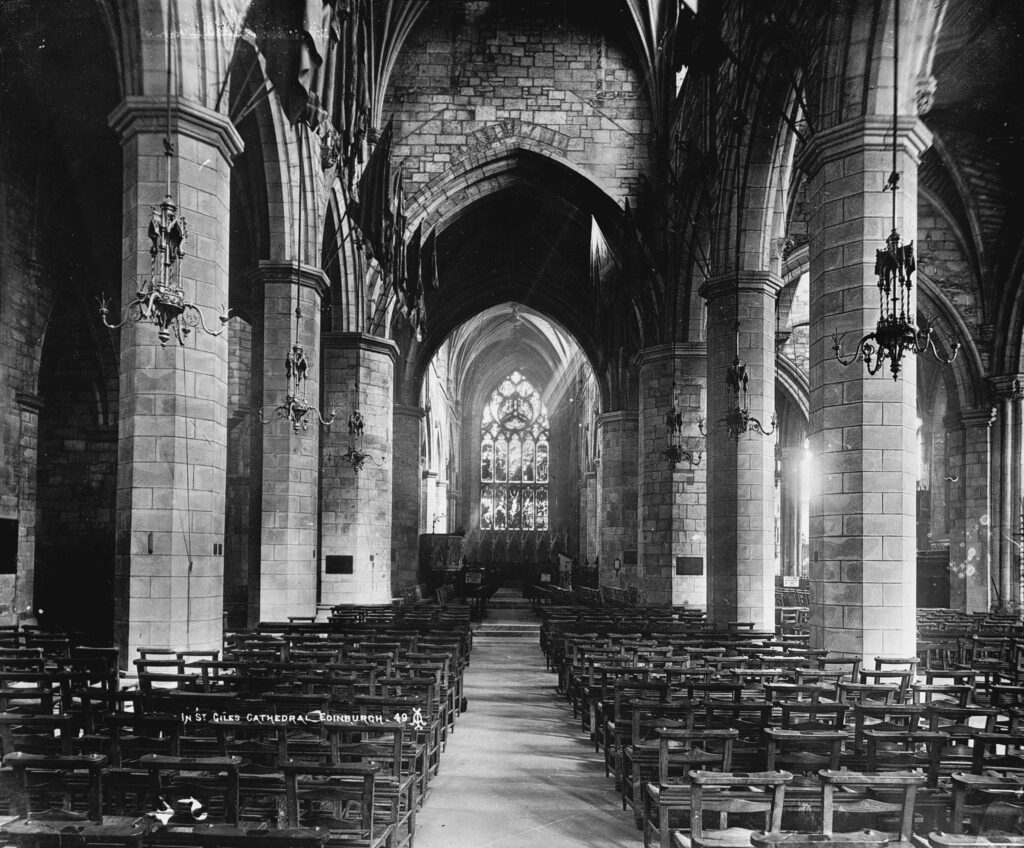
Her Majesty The Queen will lie at rest in the chancel of St. Giles’. This photo, dating to around 1900, shows a shaft of light piercing the chancel area. © Courtesy of HES (Scottish Colorfoto Collection).
Her Majesty the Queen was the first monarch to die in Scotland since James V.
The Crown of Scotland
Over the centuries many pairs of hands have had the privilege of looking after the Honours of Scotland (the Crown, Sword of State and Sceptre). These important artefacts are now within our care. It’s a duty our Collections Team take very seriously.
The current Crown of Scotland was worn for the first time in 1540 by James V at the coronation of his second wife, Mary of Guise, at Holyrood Abbey. It is crafted of gold and silver and laden with 68 pearls and 43 gemstones.
Edinburgh jeweller John Mosman was tasked with remodelling an earlier crown, which dated from at least 1503. Mosman had less than six weeks to complete the task. Its making may have been rushed but since its first ceremonial outing the Crown has seen long service – not far short of 500 years so far.
The Honours of Scotland are the oldest Crown jewels in Britain and among the oldest in Europe.
The Crown was used in the coronation of the infant Mary I, Mary Queen of Scots, in 1543. It was last used in a coronation in the coronation ceremony of Charles II in 1651.
The Sceptre is thought to have been a gift to James IV from Pope Alexander VI in 1494. It features depictions of depict St Andrew, St James and the Virgin Mary, along with stylised dolphins.
The Sword of State was gifted to James IV by Pope Julius II in 1507. It’s in very fragile condition and has now been retired from use. A replacement, The Elizabeth Sword, has been commissioned for ceremonial use.
The Honours will be be formally presented to King Charles III in a National Service of Thanksgiving and Dedication at St Giles’ Cathedral in July 2023.
Landmark for Centuries
St. Giles’ was founded in 1124 as a small Romanesque church. In the 1300s, St. Giles’ was set on fire twice. Once under the orders of Edward II and later on the orders of Richard II. Much of the Kirk we can see today largely dates from the rebuilding of the 14th century.
Within the span of its long life, it has been a parish church, a collegiate establishment and a cathedral. Although it is now known as St. Giles’ Cathedral to most people, it hasn’t technically been a cathedral since the 17th century. Its official name is the High Kirk of Edinburgh.
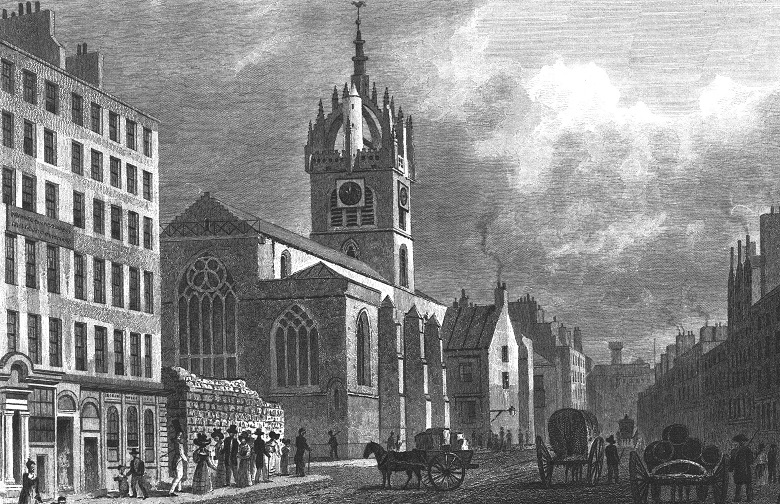
St. Giles’ Cathedral depicted in an 1829 engraving. © Courtesy of HES. Illustration from Modern Athens, T H Shepherd, 1829.
This monumental building is planted below Edinburgh Castle and high above Holyrood. When it was first constructed, it would have overlooked the hollow in which the Nor’ Loch was subsequently formed on one side. On the other, it stood above the valley that was later to become the Cowgate.

This plan of the High Street shows the layout of the Old Town in 1647. St. Giles dominates the centre of the town, beside Edinburgh Parliament House, which was built in 1639 by James Murray, Master of Works for King Charles I.
Complex construction
The earliest evidence that exists for a church on this site dates to the 12th century. Part of this can still be found within St. Eloi’s Aisle.
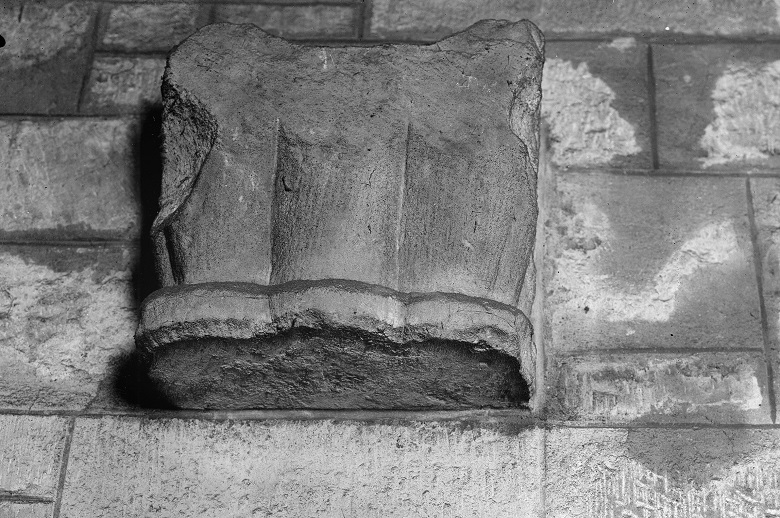
This scalloped capital is the most visible remnant of the early church. © Courtesy of HES.
The High Kirk as we know it today incorporates a range of architectural styles spanning the centuries.
The crown spire was rebuilt by John Mylne in 1648.
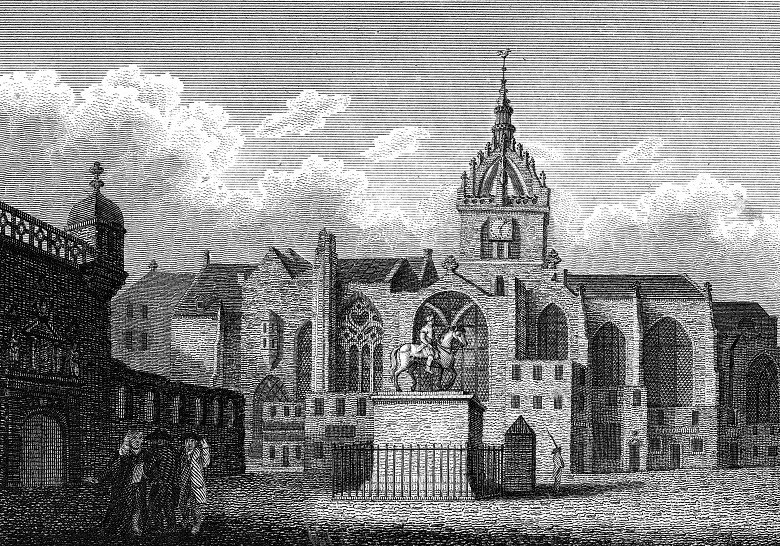
A view of St. Giles’ from 1810, prior to the 19th century renovations. © Courtesy of HES.
Extensive Renovations
During the 19th century extensive renovations took place. Between 1829-33 the Scottish architect William Burn, one of the pioneers of the Scottish Baronial style, reconstructed and re-faced much of the building we see today. Among the changes he made were the heightening of the arcade of the nave and a clerestory – an additional row of high windows – was added to make it more ‘Cathedral-like’.
Further restoration by William Hay and George Henderson in 1870-83 saw the addition of new North and West doors, a screen in the North transept and a pulpit and font sculpted by John Rhind.
One of the gems of St. Giles’ is the Thistle Chapel. This chapel is the private chapel for the Order of the Thistle, Scotland’s oldest and most senior Order of Chivalry. The Order was founded in the 15th century by James III. The Order is made up of 16 Knights and three Royal Members. The chapel was designed by Robert Lorimer and finished in 1911.
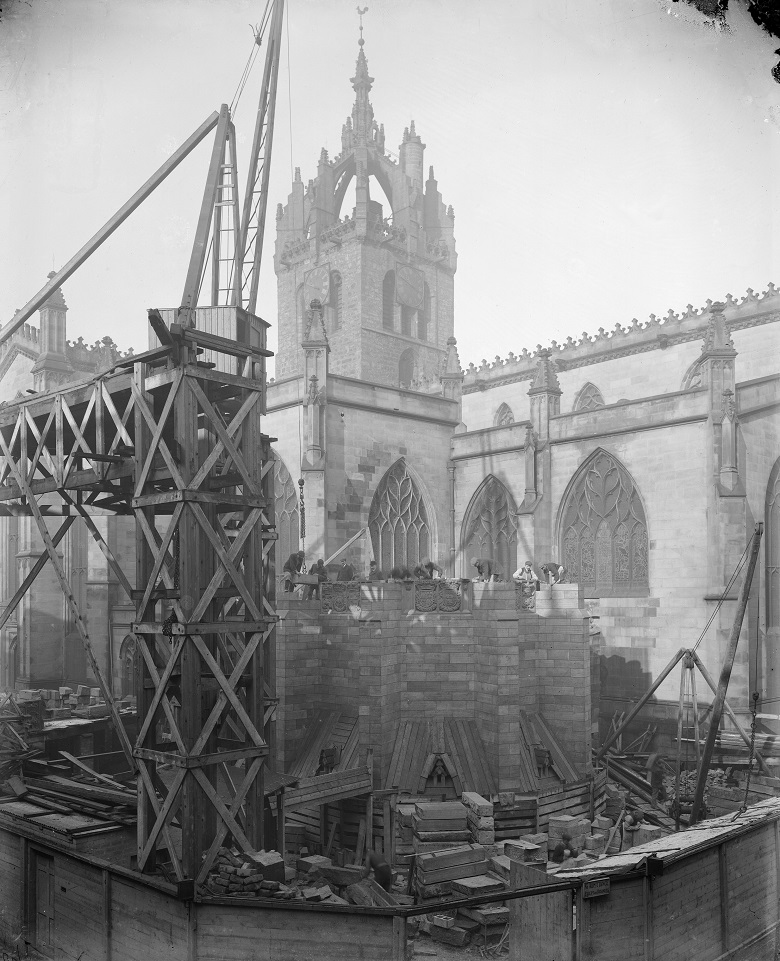
View of construction of Thistle Chapel at St. Giles’ Cathedral. © Courtesy of HES (Scottish Colorfoto Collection).
The Thistle Chapel is the most ornate building of its type built in Scotland since the Middle Ages. It contains a wealth of detail, both religious and heraldic. Much of the detail is peculiarly Scottish, including angels playing bagpipes.
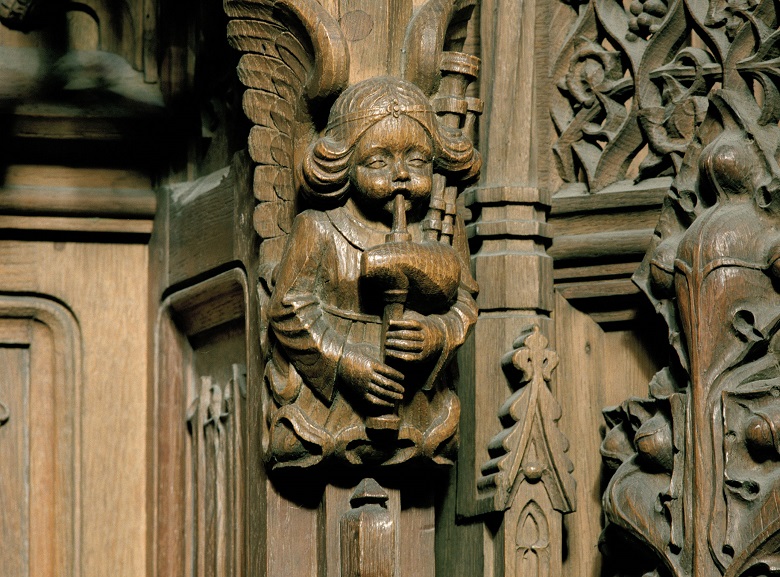
Robert Lorimer’s designs incorporated features with a Scottish flavour.
Timbers Reveal Tower’s Hidden Past
Recently, we supported new research by Dr Coralie Mills, a tree-ring dating specialist who heads up the consultancy Dendrochronicle. Her investigations uncovered some exciting information about the beams used to make the landmark tower of St. Giles’, which supports the crown spire carried on eight flying buttresses.
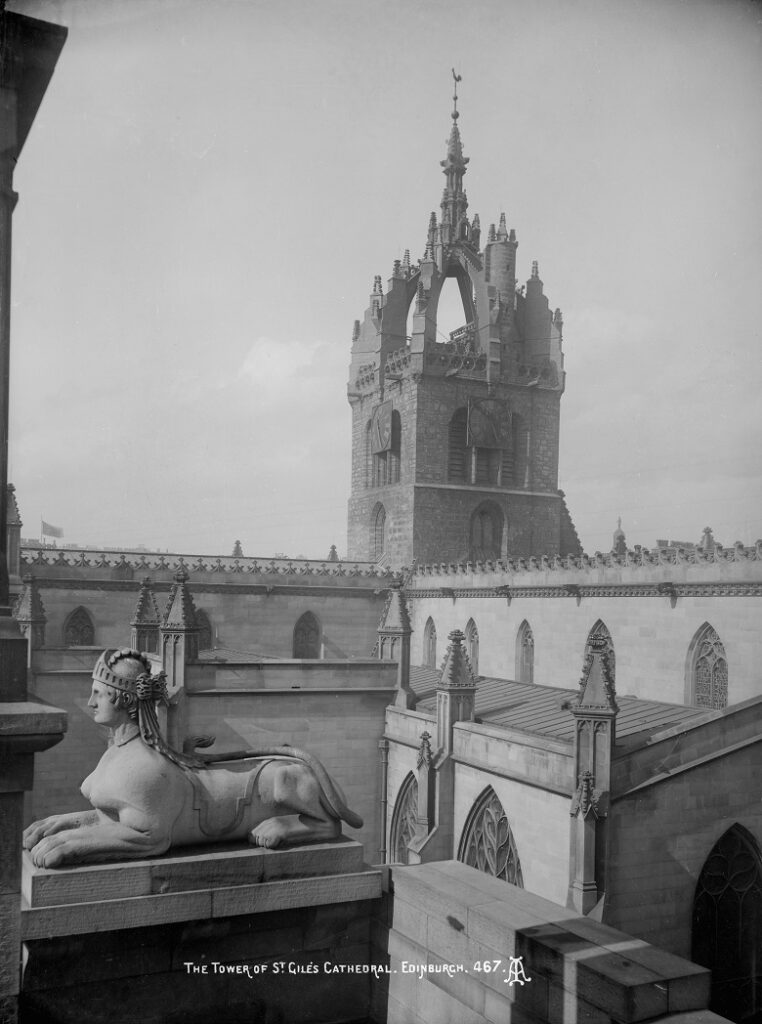
The spire of St. Giles’ viewed from the roof of Supreme Courts © Courtesy of HES (Scottish Colorfoto Collection).
Thanks to her research, we now know that the oak beams were felled in the winters of 1453-54 and 1459-60. The timbers were brought from one of the last remaining extensive reserves of old growth oak in Scotland, the Royal Forest of Darnaway, in Morayshire. The results revealed that several of the trees were over 300 years old when felled.
A Place for Reflection
St. Giles’ is a national landmark at the heart of a UNESCO World Heritage site. Over the centuries it has fostered and witnessed many changes. However, at its heart it is a place of worship and contemplation.
Banner image credit: © Courtesy of HES.

